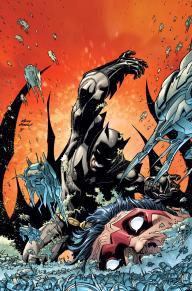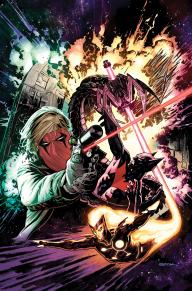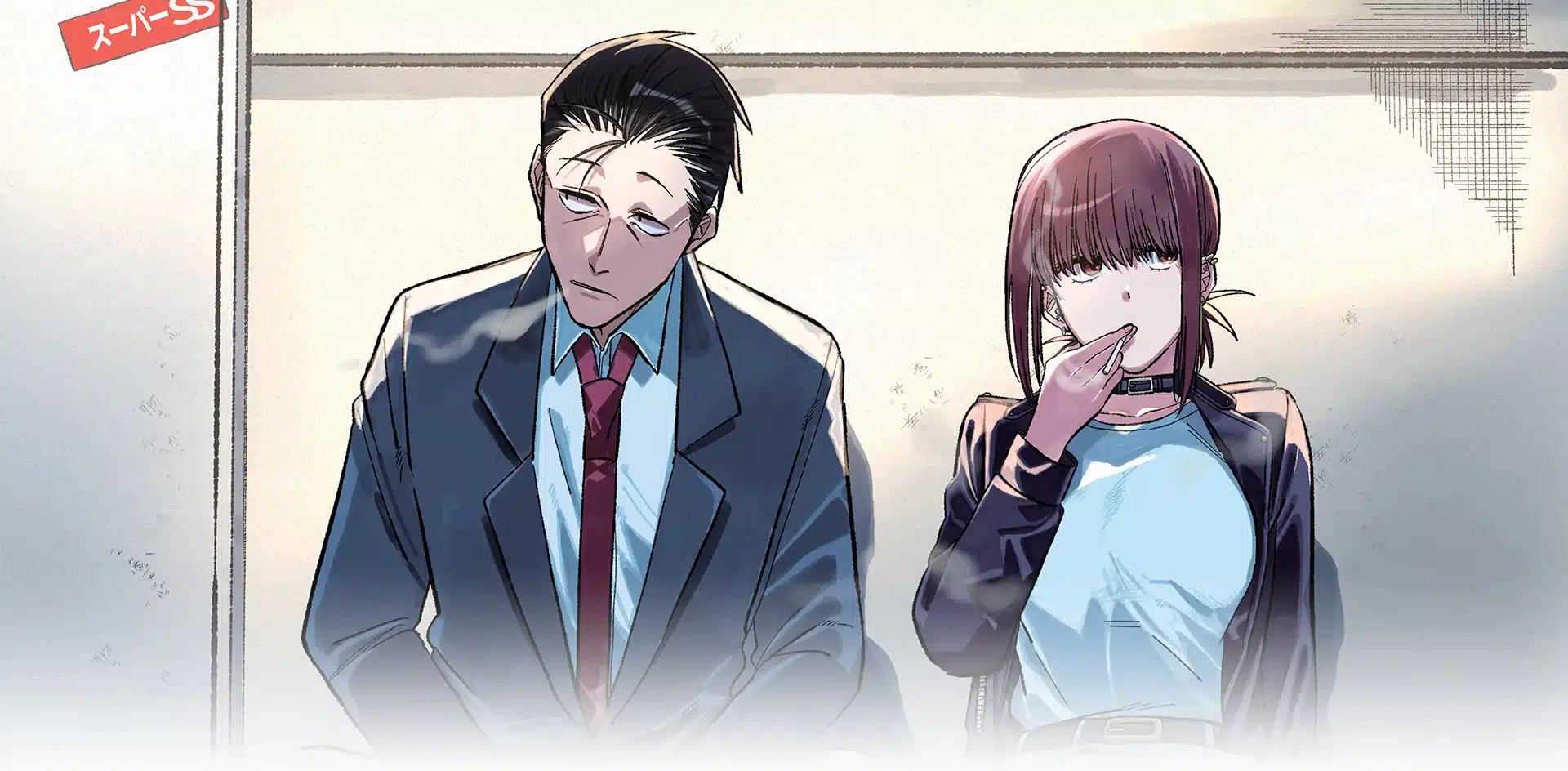You probably already know that DC has made weekly comics a big part of their strategy as they wind down their time in NYC and move to Beautiful Downtown Burbank. Two of the three series have already launched: Batman Eternal and The New 52: Futures End. The two titles couldn’t be more different and it’s time we talked about them.

On top of this, the book starts with a framing sequence of things to come. Bruce Wayne chained to a shattered Batsignal with Gotham in flames, as whoever chained him up speaks of what lead to this scene. The destruction of Gotham probably needs to go on the back burner for a decade, what with the 90s Events and the Year Zero sequence in the main Batman title right now, but it makes for an attention getting opener and the writing crew had the good sense not allude to the endgame after the first issue.
A lot going on, yes? And here’s the kicker — it’s one of the better comics DC is putting out right now. Granted, I’m not nearly the fan of Synder and Capullo’s Batman run that most people are, but I’m enjoying this more than the flagship title. To be fair, Batman Eternal may not be done setting the table with five issues out. Issue six is announced as “A Mad Ghost Story” and that suggests the Spectre plot will get a full start then. Still, the act of setting the table has been both entertaining and done at a reasonable pace — quick enough that the plots are moving forward, but not so quick as to seem like shorthand.
Structurally, the first three issues (scripted by Scott Snyder and James Tynion with Jason Fabok on art) are the primary setup. Issue 4 (script by John Layman and art by Dustin Nguyen and Derek Fridolfs) is really more of a Batgirl comic with Batman providing a link to the overall plot arc. Issue 5 (Script by Tynion and art by Andy Clarke) is really a Red Robin comic with Batman appearing for a similar role. As the primary setup ends, it feels like we’re getting chapters with the supporting characters off doing their thing and we should get back to what Batman’s concentrating on in another issue or two. Thus, the effect 100 pages in is that of a serialized novel and we’re getting a chapter a week. Not the easiest trick to pull off with something that’s essentially created with a bullpen of creators.
We should talk about that bullpen, too. Each issue’s writing credits is broken down into three parts: story, script and consulting writers. The story is by Snyder and Tynion. The script seems to be who’s writing the individual issue and then the consulting writers are whoever’s not writing the individual issue between Layman, Ray Fawkes and Tim Seeley. (Layman is scheduled to bow out in a few issues.) They’re doing a pretty good job of explaining who’s doing what for this one. Artwise, we’ve got three artists in the mix and there will doubtless be more to come before the year is out. Fabok and Clarke are similar enough art styles, there’s not a ton of cognitive transition going from one to the other. Nguyen’s style is a little more open and doesn’t fit quite as close, but if he’s following Batgirl’s arc, it will likely work out in the long run. Matching artists by style is one of the more difficult tasks an editor faces in this era of rotating creators and titles that ship more than once a month.
A good start and if you like Batman, you should probably give Batman Eternal a look. The only people I’d say should stay away from this one are people who don’t like Batman or who don’t want to add $12/mo to their comics bill. The weeklies, their cost adds up.

Given that #0 isn’t online, I’m going to go into spoiler territory — skip the next paragraph if you don’t want things spoiled, although you could pretty much guess most of the issue from the promotions:
35 years in the future, Brother Eye has taken over. The superheroes are all turned into “bug” cyborgs. Including John Constatine, which seemed a little odd, since he didn’t have powers, per se. Firestorm is powering the cyborgs and after a last ditch attempt to disconnect Firestorm from the power grid fails and gets everyone killed, a senior citizen Batman gets ready to jump back in time and kill Mr. Terrific, ensuring Brother Eye doesn’t get built. Alas, he’s over-run by more cyborg superheroes, gets his arm chopped off, and is forced to send Terry, his apprentice – better known as Batman Beyond – back in time instead. Whoops. He arrives 5 years too late and Brother Eye is already built.
OK, spoilers over. Issue #1 finds Batman Beyond trapped 5 years after his target and 5 years ahead of current DC continuity. His original mission is a scrub. Brother Eye has been built and bad things are starting to happen. And a lot of people die, or at least appear to die. In the first two issues, there’s a really high body count.
There’s a rule of thumb that might be applied to this book, and it centers around how “The New 52” is part of the title. If you like the darker, more violent, high body count aspects of the New 52, odds are you’ll like this book. If you’re scratching your head and wondering how the 90s gritty era took over most of the line, this probably isn’t the book for you. I can honestly say, this read EXACTLY like I expected based on the promotion. It’s well enough done for what it is.
The subplot in #1 involves Grifter hunting down and killing alien invaders who’ve taken human form. Most likely, we’re talking Daemonites and since it’s been widely speculated that Futures End will somehow lead to Jim Lee bringing WildC.A.T.s to the New 52 universe, I’d say that rumor looks possible.
What did _I_ think of the first two issues? Frankly, I was a little bored. The cyborg superheroes in #0 reminded me a great deal of the possessed/reanimated superheroes from Rotworld. The surviving heroes hiding in the rubble? Days of Future Past, maybe a touch of Old Man Logan. You need to go back to the past and kill someone to prevent this from happening? Age of Ultron. And that’s just my initial recollections of the comics it appears to be cribbing from. That isn’t talking about Terminator and the like.
Issue #1 also felt a bit expository at times. Like some of the plot points were being written down for a younger audience, a problem I sometimes have with Justice League. And a problem that’s all the more curious for a book that’s largely about body count.
Two issues in, there haven’t been enough twists to break it out of being an amalgamation of things that have come before. The hook of arriving too late was part of the promotion, so its not really a twist when reading it. It doesn’t help that last week’s Flash Annual, (the one re-imagining Wally West as Jason Todd) is centered around the Flash twenty years in the future deciding to return to the past to keep Wally West from dying. Running those two storylines at the same time? Comics have gone to the time travel hook too much and it’s time to let that trope rest a bit.
The writing credits on this are interesting as well. Brian Azzarello, Keith Giffen, Dan Jurgens and Jeff Lemire are all credited. Are they each writing a character arc, flashing back to the method of (The Old) 52 and Countdown? Is it by committee? No idea. The art on the #0 issue is split between Ethan Van Sciver, Patrick Zircher, Aaron Lopresti Dan Jurgens and Jesus Merino. The art on #1 is by Patrick Zircher. The art may be the highlight. Its a solid group, with similar enough styles. The transitions were very smooth in #0.
But, as I said, your opinion of this book is going to be a referendum on the direction of the DCU. If you like a high body count (especially with heroes buying the farm) and a dark theme, this might be for you. If you look at it strictly as an action book, it’s well constructed. If you’re really into time travel stories, this could work for you. If you’re wondering why the DCU has become such a dark place or are bored with heroes constantly getting killed off, stay far away.



